With the increasing use of generative artificial intelligence (AI) in business, phases where companies use generative AI to engage in dialog with their customers and to enable customers to consult them have emerged in the marketing funnel. It is expected that this will extend companies' ability to reach potential customers, to improve services provided to existing customers and to increase repeat purchases.
Dentsu Digital established the GDO-AI Lab joint research laboratory with Golf Digest Online Inc. (GDO) to explore the possibilities of "dialog" and "consulting" using generative AI. Currently, demo versions of GDO Shop Clerk AI and GDO Virtual Fitting are being developed. The first is an AI chatbot that serves each user in the manner best suited to them. The second is a virtual fitting service to be used on e-commerce websites.
We interviewed Hirotoshi Kato of GDO and Satoru Yamamoto of Dentsu Digital about the goals and actions in this project and about the potential of generative AI, which is coming into a phase in which it can be used practically by anyone.
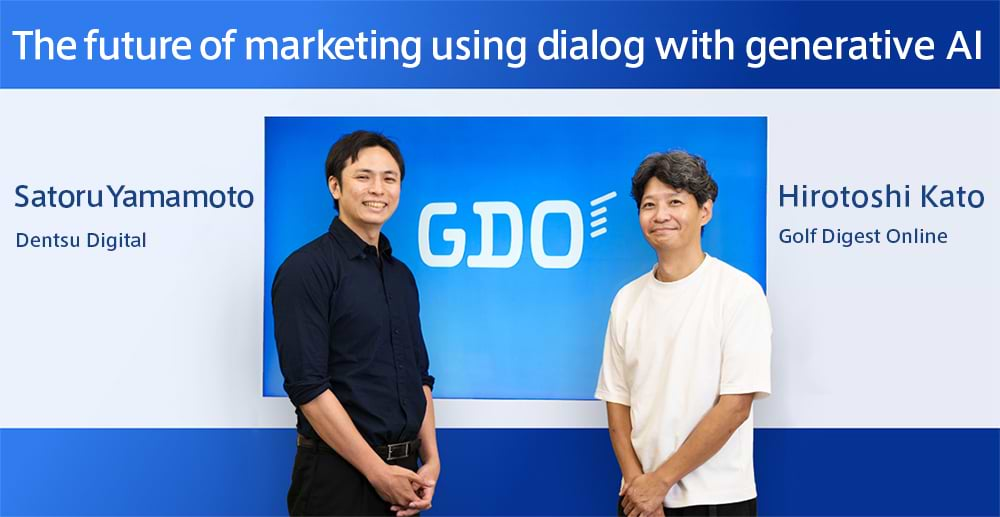
It is believed that there is great potential for Generative AI to impact the customer experience.
—You are currently developing GDO Shop Clerk AI and GDO Virtual Fitting. What are these services?
Kato: GDO Shop Clerk AI is an interactive AI service that can be embedded on webpages to enable people to book tee times at golf courses. Responding to users' questions about golf courses, the AI naturally converses with them to understand the wishes and preferences of individual users in detail, as well as their latent needs, and it makes suggestions that are best suited to the individual user.
Users can also engage in a dialog with the AI to review golf courses after they have played golf. The AI will propose items that match their needs and golf courses where they can play in the future. We have accumulated a massive number of golf course reviews by members. We have our AI learn this information and tune the AI. Then, it is capable of providing highly precise proposals based on data that is not available from the official information provided by golf courses.
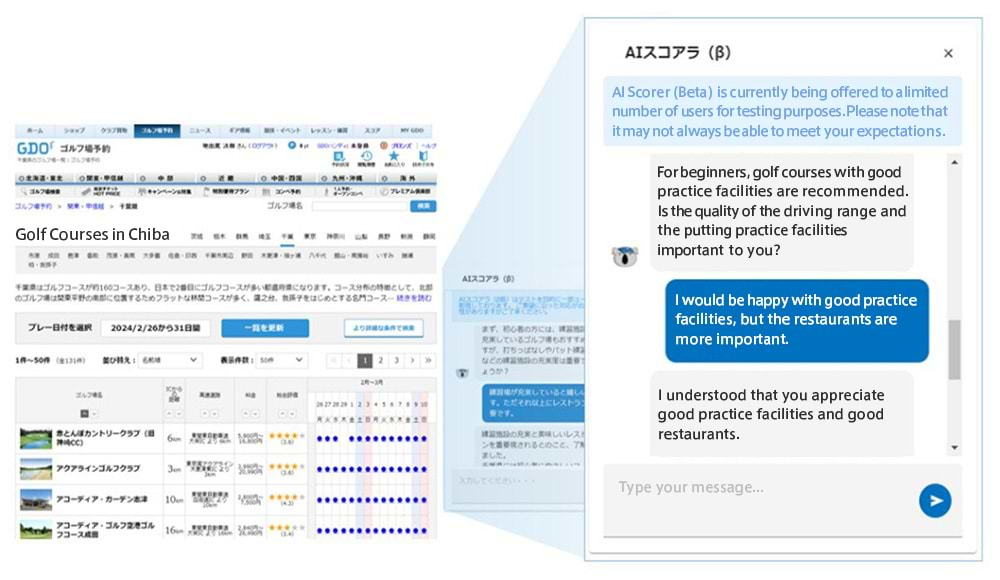
GDO Virtual Fitting is a service that enables users to upload a photo of themselves to an e-commerce website to virtually test the of fit of tops, bottoms and other pieces of clothing. After analyzing and learning product data, the AI produces an image of the user wearing a particular item. This enables users to have a concrete image for coordinating outfits that look good on them. It prevents problems with discrepancies in the appearance of products that have been ordered on an online shop and eliminates the effort of trying on a number of items of clothing in a brick-and-mortar store. It provides a shopping experience in which it is fun to choose items.
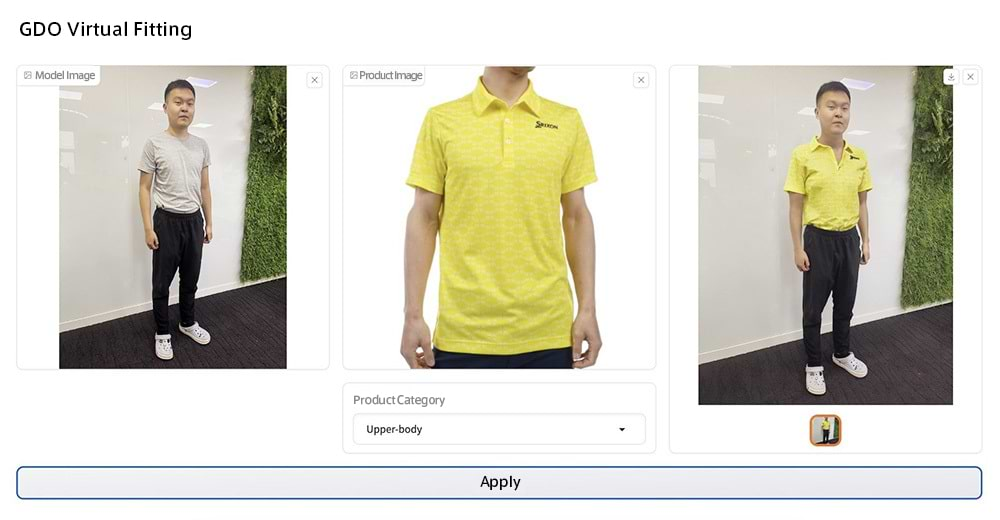
—I feel that these projects are leading-edge efforts that had not been done in the golf industry. What were the reasons behind the start of these projects?
Kato: Our company has long been working to actively use data and technologies. I joined in 2017 in the middle of my career. At that time, I was astonished to see data already neatly organized and effectively used in various situations.
As technologies have been quickly advancing in recent years, the marketing environment is increasingly becoming sophisticated and complicated. Due to this, I felt overwhelmed because I was failing to finish all of the various tasks that I had to complete. The excessive pursuit of efficiency created an issue where marketing measures became mundane. When I searched for new tools that would make big differences in the customer experience, a Dentsu Digital staff member who was acquainted with me as a partner in programmatic advertising introduced me to Mr. Yamamoto.
Yamamoto: In our free exchange of opinions during lunch, the idea of a shop clerk AI came up. At that time, I felt the idea had tremendous potential, but I still had very little idea about what it could do.
—At what point did you understand its potential?
Yamamoto: First, GDO's management team was positive about the use of technology. They were strongly determined to try out new things in this area in a company-wide way. And GDO deals broadly with so many areas related to golf that there was potential to create an AI that combines data about all kinds of golf experiences. That was just at the time when generative AI and other technologies were rapidly advancing. I was excited to be able to try to implement a project using cutting-edge technologies.
—The project was launched as a joint laboratory. What is the intent or aim of the project?
Kato: The term shop clerk AI came up first, and then we began by looking at the possibilities of what it could do with the data we actually had. We hoped that GDO would conduct research with us, instead of it being merely a contractor relationship.
Yamamoto: The area of generative AI in particular is still in its infancy. It is possible that a technology that is considered to be the best technology at a specific point in time may be replaced with a better technology a week later. To adapt flexibly to changes like this, a framework for joint research that was based on demonstration experiments was the most favorable option. In addition, we felt reassured that labor had been clearly divided. We were responsible for the verification of generative AI technologies and the development of logic, while GDO was responsible for the implementation of technologies to make services and use them in marketing.

Dividing the dialog into several steps and employing LLMs customized for the individual steps to increase accuracy nearly threefold
—How did you implement verification and development at the GDO-AI Lab?
Yamamoto: As Mr. Kato said earlier, the big data that GDO provided us was highly organized. It was surprising even for us who had been handling a wide range of corporate data. Additionally, the data included not only general data about golf courses but also a large volume of users' views and other comments.
For example, one comment said the shower water pressure was high at one golf course and another that the course had a kind caddie. Information like this is not found on official websites. We fed the data, including deep insights like these, into the AI to construct what we call the DNA of Golf Courses. It is a collection of information about users' interests.
Kato: The DNA of Golf Courses contained the insights that we, who have been engaged in the golf business for a long time, agreed on. Every comment was convincing, but we failed to make them visible in a well-classified form. I realized the power of what the AI can do.
Yamamoto: In addition to this DNA of Golf Courses, we have introduced our own original technology, Multi-Step Scenario Control. This technology uses multiple large language models (LLMs) customized for individual dialog steps.
For example, it would be unnatural in a conversation if the AI suddenly starts the chat by saying, "Hello. I recommend this golf course to you." To prevent this, it starts with an ice breaker to initiate a general conversation, such as "Are you playing golf for the first time? How long have you been playing golf?" After this step, the AI goes on to the stage of asking for necessary information such as the region that you wish to play golf in, the number of players and the date you want to play golf, to create a short list of golf courses. After narrowing the list of prospective golf courses somewhat, the AI moves to the final step of proposing the golf courses it recommends to users.

Yamamoto: The user experience is a dialog with a single AI, but behind this dialog, different LLMs that have been customized for the general conversation stage, the golf course search stage and the golf course proposal stage operate separately. The AI always identifies the stage of the dialog and collaborates with the LLMs to provide a seamless experience. This results in accuracy that is nearly three times greater than solutions implemented using a single LLM.
Kato: The AI also identifies what stage the ongoing dialog is currently in. I was surprised that the dialog was more natural than I had expected.
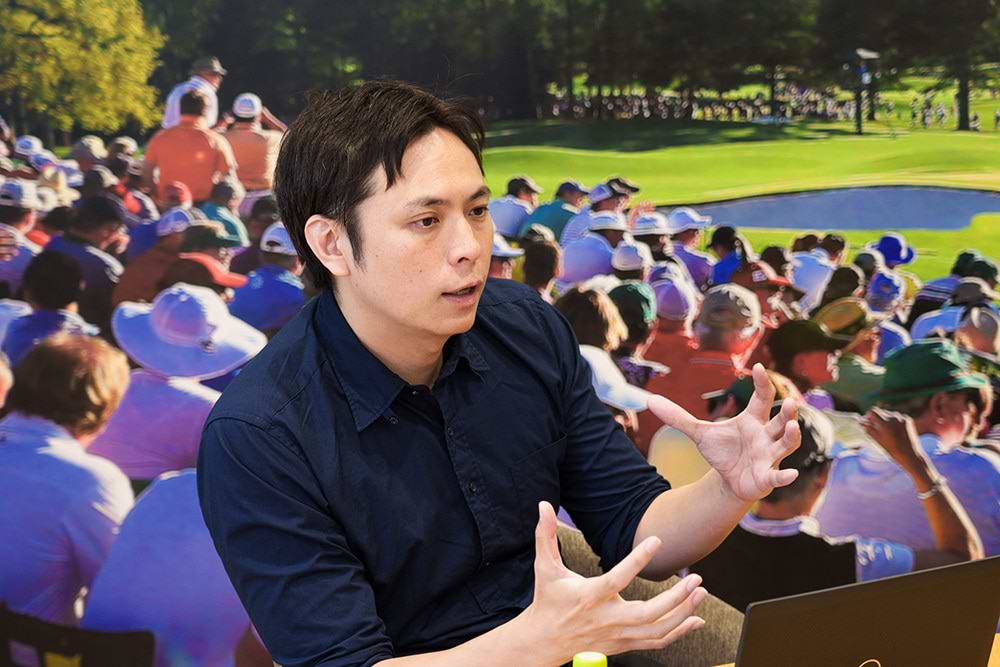
On average, a dialog lasts three minutes and the user provides five responses. The dialog between the AI and the user is lively, which enables the extraction of further insights.
—What were results of the demonstration experiment?
Yamamoto: As a pre-release demonstration experiment, we implemented GDO Shop Clerk AI on some landing pages of websites to provide users with the experience of using it. In the experiment, it was observed that the AI extracted insights from 70% of the users starting a dialog and that 80% of them reached the product proposal stage. They engaged in a dialog with the AI for an approximate average of three minutes.
I was surprised that humans could converse with the AI so naturally (laughs). Users were allowed to engage in dialogue with the AI after they played golf. The AI received an approximate average of five responses. GDO's hypothesis was that golf players like to talk a lot about their own experience playing afterwards. The results proved that GDO was right.
Kato: Yes. The content of the dialogs was in line with our hypothesis. They reviewed their own play and talked about what was successful and attributed their poor performance to clubs and playing conditions. We had some anxiety about making it accessible to users during the testing stage, but there was significant progress in the project after the trial confirmed that our hypothesis was correct.
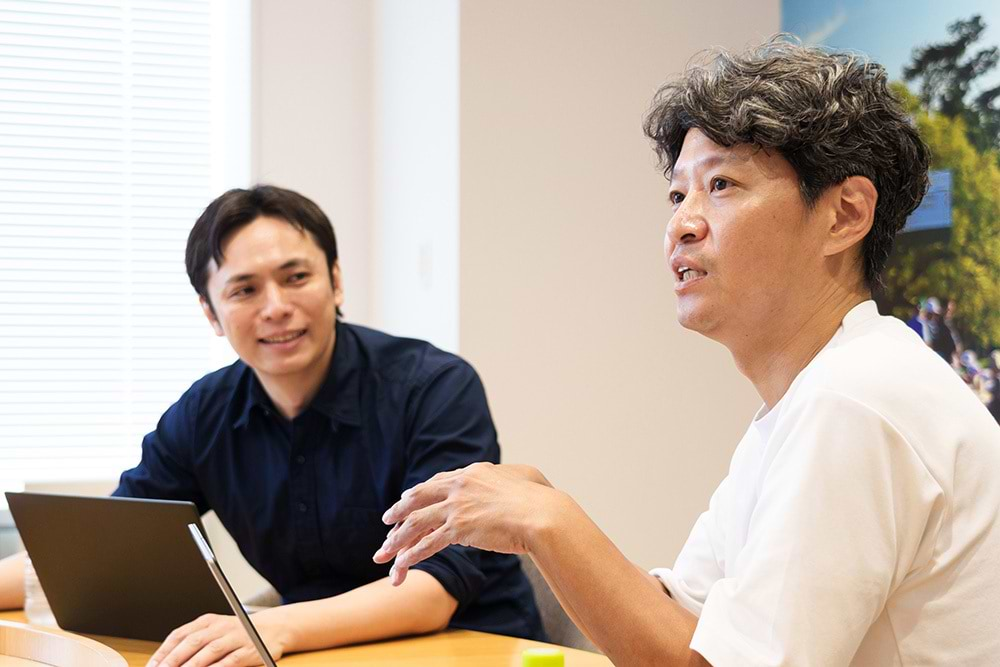
—How did people inside and outside the company react?
Kato: We reported the results of the demonstration experiment in a private companywide chat, and we received tremendous reaction. Many members expressed their desire to participate in the next trial. I feel the trial was a good trigger for conversations about the utilization of AI in many different places in the company.
Yamamoto: We presented this during Direct Agenda 2024, a conference of marketers in and outside Japan, and won an Agenda Award. Agenda Awards are presented following a vote that leading marketers from around 300 companies participate in. The fact that participants from various business sectors and different business styles feel that this initiative has potential gave me confidence.
We had provided a wide variety of clients with solutions regarding the use of generative AI to streamline operations. This project demonstrated that the generative AI can potentially help enhance the user experience. Afterwards, we received inquiries from a very large number of customers.
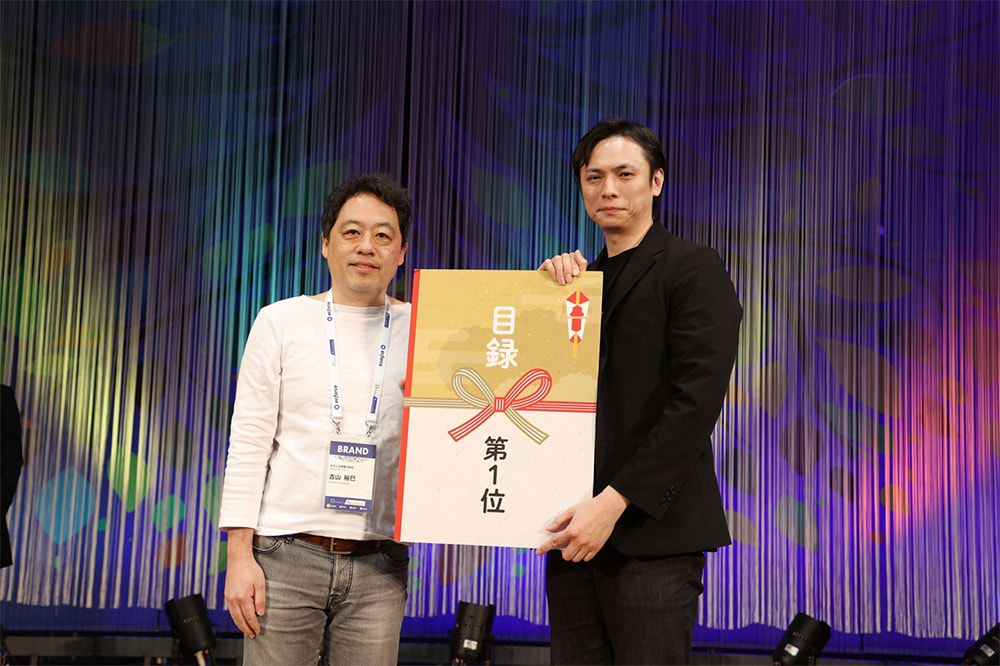
The evolution of generative AI opens the way to an era where companies can create their own economic zones.
—We have heard that the services currently being developed are demo versions prior to their full introduction. Could you tell us details about development as you move towards their official release?
Yamamoto: A function of GDO Virtual Fitting is that it generates a virtual image of users wearing specific clothing using images they upload. In the future, we will be adding virtual fit testing that combines information about items they have purchased in the past, the proposal of coordinated clothing and the recommendation of similar items.
Take coordinated clothing proposals, for example. We will input outfit coordination data as recommended by GOD shop staff who have a good deal of knowledge about style. We are trying to reproduce stylists' sense of fashion, something that is difficult using text data alone.
Kato: One example is that the combination of a top with a vivid blue border print and yellow sporty pants may sound nice when you read about it, but it may not look good when it is worn. We will enter data about good and poor style choices into the generative AI to offer an experience that is like a real fitting in consultation with shop clerks on e-commerce sites.

—What will you work on at the GDO-AI Lab?
Kato: We will not stop with GDO Shop Clerk AI and GDO Virtual Fitting. We will collect and analyze users' reactions and feedback at all points of contact with them and input them into the generative AI. I believe that this will be helpful not only for improving the user experience and to operational assistance to marketers inside companies.
Suppose that we number the series of responsibilities that marketers implement from steps 1 to 10. I imagine a future in which steps 1 to 10 will be delegated to a generative AI and the marketers will be able to concentrate their creativity on the process of creating ideas for steps 0 and 1, and the finishing process, 10.
Yamamoto: I hope we will combine AI and GDO's abundant user and content data to develop a GDO Economic Zone in which the customer experience will be richer in all service domains. Traditionally, a huge amount of data has been needed to establish an economic zone like this. Individual companies do not have enough data or a sufficient ability to handle the large volume of data if does have this data. This has been a bottleneck.
However, as in this project, including AI dialog and consultation in the points of contact with users will pave the way toward the acquisition of a lot of deep insights from users in a short period of time. In addition, generative AI will quickly enable people to see the bulky data in an organized way. I believe this will allow a single company to build a large economic zone.
Kato: While expanding the economic zone, we aspire to maximize the value of the services that we alone can provide and to enable more people to have enjoyable golf experiences. Since we are a golf company, our mission is to enable golfers to have experiences that are delightful, joyful and useful. To fulfill this mission, we will make good use of generative AI and other technologies. With the support of Mr. Yamamoto and other experts in this field, we will proactively work to implement leading-edge initiatives.
